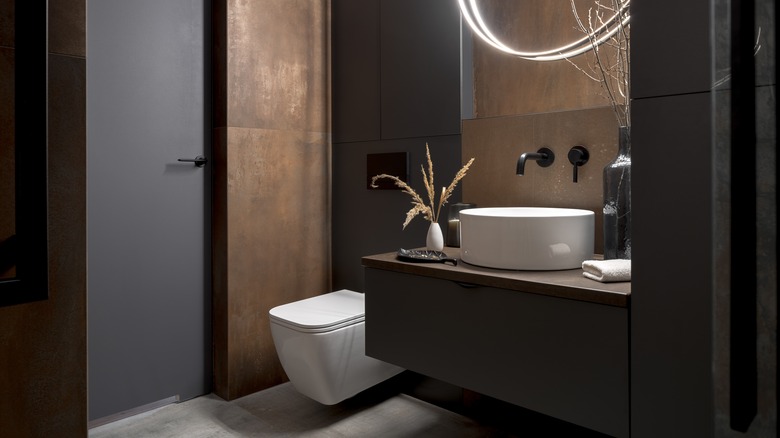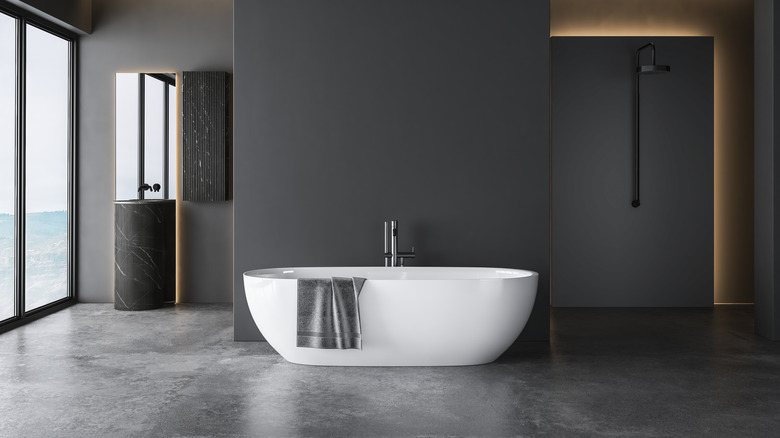The Main Issues With Using Dark Paint In The Bathroom, According To Our Paint Expert
If you're preparing to paint your bathroom and are thinking of using a darker color, you may be wondering if it will really look as gorgeous as you're imagining. Luckily, Sue Wadden, director of color marketing for Sherwin-Williams, spoke exclusively with House Digest about dark walls and how they can make or break your bathroom. According to Wadden, dark paint may look great in some bathrooms, but you need to consider how it will change the room's appearance. "A dark hue in a bathroom can be a showstopper when used correctly, but it can sometimes create the illusion that the room is smaller because dark shades absorb light," Wadden explained. "When considering a dark color for your bathroom, it is all about the lighting."
For those who have cramped bathrooms without much light, painting all four walls a deep color might make the room feel claustrophobic; however, if you think it could enhance the room, there's no harm in trying. "Sometimes homeowners also have a bit of decision paralysis when weighing their dark color choices, but it is important to remember that you can start small, and nothing is permanent," Wadden said. By following Wadden's tips for painting with dark colors, you can make your bathroom pop.
Executing a dark paint job in the bathroom
When Sue Wadden spoke exclusively with House Digest, she stressed that though deeper paints will make some bathrooms seem smaller, it can be a stylish choice in others. "If you have a spacious bathroom with lots of natural light, a dark color can add a dramatic pop without overpowering the room," she explained.
For those who have already painted their bathroom walls with a dramatic hue and discovered that it does take over the space, Wadden has some advice for tying the room together. "If you already have a space with four dark walls, try adding whites and neutrals to balance the dark hues," she said. "I also love adding natural materials for calming dimensional texture and lightness."
"Neutral [tiles] work or wainscoting can also be a great way to level up a bathroom and provide contrast," Wadden continued. Even if you do have a small bathroom, darker paints can still work as long as other features in the room are lighter. Additionally, you may consider only painting part of your bathroom with a dark purple, green, or gray, rather than the entire room.
Using dark paint for a bathroom accent wall
Rather than jumping to repaint your entire bathroom with a deep hue, Sue Wadden suggested exclusively to House Digest that accent walls can liven up your home. If you paint only one wall, you could add depth and a unique look to your bathroom while also deciding if the color would look good throughout the rest of the room or not. Wadden also mentioned that dark accent ceilings are a great option for bathrooms.
Wadden explained that you'll want to evaluate which wall to paint a dark color so that the room doesn't lose its spacious feeling. "For an accent wall, consider painting the tallest wall in a room filled with lots of natural light to give the effect that the room is larger," she said. "A deep shade can really create a luxurious feel when painted behind a tub or vanity."
Additionally, Wadden mentioned that painting furniture, like a vanity, in a dark color could provide an interesting bathroom aesthetic. If you're concerned about choosing the right dark color, Wadden suggested checking out Sherwin-Williams' Colormix Forecast 2024 Anthology: Volume 1. She explained that the third palette has a wonderful selection of dramatic hues while palette four has some lighter contrasting colors that could help inspire your bathroom decor.


